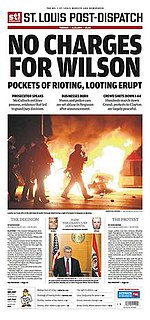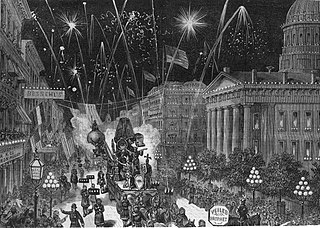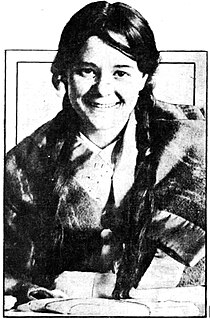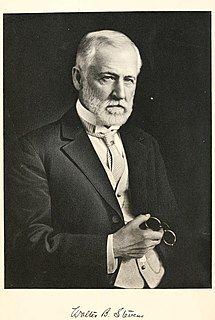Related Research Articles

Webster County is a county located in the U.S. state of Missouri. As of the 2010 census, the population was 36,202. Its county seat is Marshfield. The county was organized in 1855 and named for U.S. Senator and U.S. Secretary of State Daniel Webster.

The St. Louis Post-Dispatch is a major regional newspaper based in St. Louis, Missouri, serving the St. Louis metropolitan area. It is the largest daily newspaper in the metropolitan area by circulation, surpassing the Belleville News-Democrat, Alton Telegraph, and Edwardsville Intelligencer. The publication has received 19 Pulitzer Prizes.

The 1896 St. Louis–East St. Louis tornado was a historic tornado that caused severe damage to downtown St. Louis, Missouri, East St. Louis, Illinois, and surrounding areas on Wednesday, May 27, 1896. One of the deadliest and most destructive tornadoes in U.S. history, this tornado was the most notable of a major tornado outbreak across the central United States which produced several other large, long-track, violent tornadoes and continued across the eastern United States the following day.
The St. Louis Globe-Democrat was originally a daily print newspaper based in St. Louis, Missouri, from 1852 until 1986. When the trademark registration on the name expired, it was then used as an unrelated free historically themed paper.

On August 21, 1883, a devastating tornado affected southeastern portions—the Driftless Area—of the U.S. state of Minnesota. The massive tornado, retrospectively estimated to have been an F5 on the modern Fujita scale, caused at least 37 deaths and over 200 injuries. The tornado was part of a tornado family, a series of tornadoes produced by a supercell, that included at least two significant tornadoes across Southeast Minnesota on August 21. A third significant tornado occurred two hours before the main event hit Rochester. The Rochester tornado indirectly led to the formation of Saint Mary's Hospital, now part of the Mayo Clinic. The tornado closely followed destructive tornadoes a month earlier in the same area: on July 21, two significant, deadly tornadoes hit the area, including an F4 tornado family that killed four people in Dodge and Olmsted Counties, especially near Dodge Center.
Benjamin F. Abell was a professor of meteorology in the Department of Earth and Atmospheric Sciences at Saint Louis University (SLU), where he was a member of the faculty from 1962-2011. He also volunteered as the sole meteorologist for St. Louis, Missouri public radio station KWMU-FM since the station began broadcasting in 1972 through early 2007. To recognize and preserve his contributions as an outstanding member of the St. Louis radio community, Abell was a 2005–2006 inductee to the St. Louis Radio Hall of Fame.

Robert Washington Fyan was a U.S. Representative and soldier from Missouri.

The Veiled Prophet Ball is a debutante ball held each December in St. Louis, Missouri.

The tornado outbreak sequence of May 2003 was a prolonged and destructive series of tornado outbreaks that affected much of the Great Plains and Eastern United States in early May 2003. Most of the severe activity was concentrated between May 4 and May 10, which saw more tornadoes than any other week-long span in recorded history; 338 tornadoes occurred during this period, concentrated in the Ozarks and central Mississippi River Valley. Additional tornadoes were produced by the same storm systems from May 3 to May 11, producing 401 tornadoes overall, of which 65 were significant. Six of the tornadoes were rated F4, and of these four occurred on May 4, the most prolific day of the tornado outbreak sequence; these were the outbreak's strongest tornadoes. Damage caused by the severe weather and associated flooding amounted to US$4.1 billion, making it the costliest U.S. tornado outbreak of the 2000s. A total of 50 deaths and 713 injuries were caused by the severe weather, with a majority caused by tornadoes; the deadliest tornado was an F4 that struck Madison and Henderson counties in Tennessee, killing 11.

Jane Frances Winn who wrote as Frank Fair, called the "dean of newspaper women" in St. Louis, was an influential American journalists of the early 20th century. By 1903 she was recognized as a journalist to whom "even men" paid their homage: The Journalist, a New York City weekly periodical about newspaper people and their work, profiled Winn in its series of prominent writers.

The 2020 United States House of Representatives elections in Missouri was held on November 3, 2020, to elect the eight U.S. Representatives from the state of Missouri, one from each of the state's eight congressional districts. The elections coincided with the 2020 United States presidential election, as well as other elections to the House of Representatives, elections to the United States Senate and various state and local elections. The primaries were held on August 4.

Marie Moentmann (1900-1974) was a 15-year-old girl who lost her hands and full use of both arms in a factory accident in 1915 in St. Louis, Missouri.

Alonzo William Slayback (1838-1882), a lawyer, was an officer in the Confederate Army and a founder of the Veiled Prophet parade and celebration in St. Louis, Missouri. He was shot and killed by the managing editor of the St. Louis Post-Dispatch.
Charles E. Slayback (1840-1924) was a grain merchant in New Orleans, Louisiana, and St. Louis, Missouri. He was a founder of St. Louis's Veiled Prophet Organization.
William Elisha Hyde (1836-1898) was an American journalist, the managing editor of the Missouri Republican newspaper of St. Louis, Missouri, for nineteen years.
Nathaniel Paschall (1802–1866) was a 19th-century American journalist, the editor of the Missouri Republican.
The Missouri Republican was a newspaper founded in 1808 and headquartered in St. Louis, Missouri. Its predecessor was the Morning Gazette. It later changed its name to St. Louis Republic.

Walter B. Stevens (1848-1939) was a journalist and secretary and publicity director of the Louisiana Purchase Exposition Company and the author of books on the history of Missouri.

George Smith was an American politician who was active in Ohio and Missouri. He was most notable for his service as Lieutenant governor of Missouri from 1865 to 1869, and United States Marshal for the Western District of Missouri from 1869 to 1877.
References
- 1 2 3 4 "Death of Professor Tice," The Republican, Ottawa, Kansas, December 6, 1883, image 3
- 1 2 3 4 5 R.T., "Weather Prophets Share Usual Fate," St. Louis Daily Globe-Democrat, July 23, 1905, image 37
- ↑ Jenks, "St. Louis Journalists," St. Louis Post-Dispatch, March 14, 1883, image 8
- 1 2 St. Louis City death certificate
- ↑ "Suburban St. Louis," St. Louis Post-Dispatch, June 13, 1877, image 2
- ↑ Missouri Newspaper Death Index, 1822-1994
- ↑ "Legal Notes," St. Louis Daily Globe-Democrat, December 18, 1884, image 9